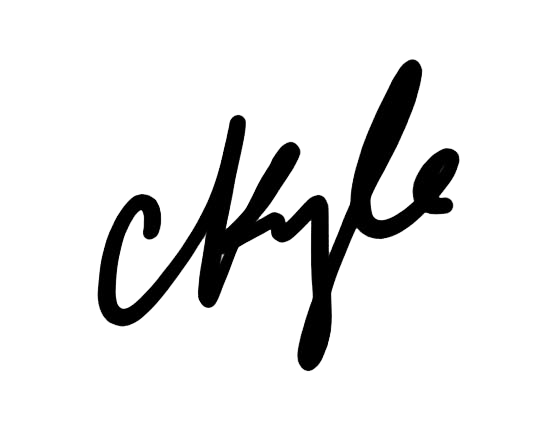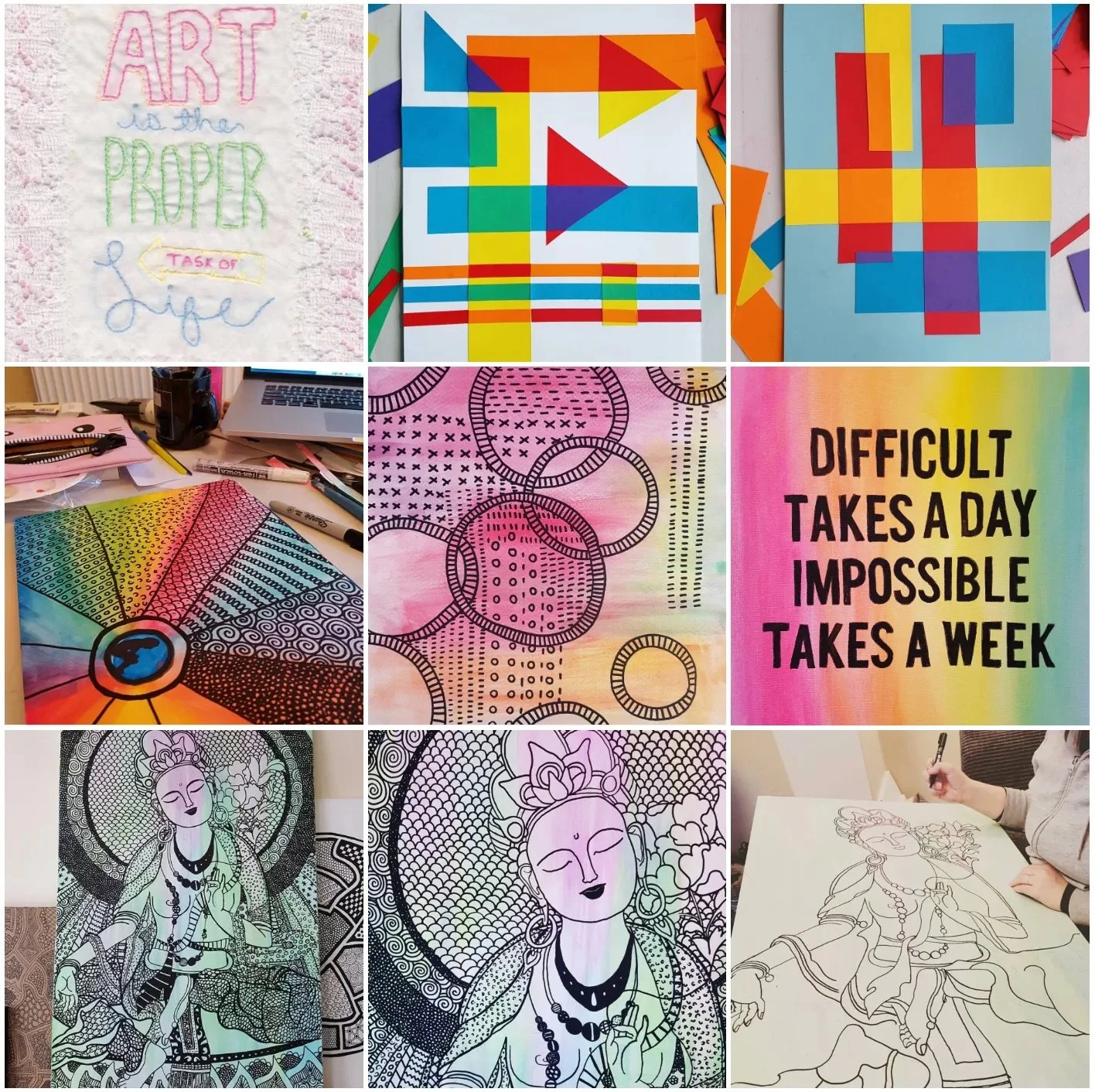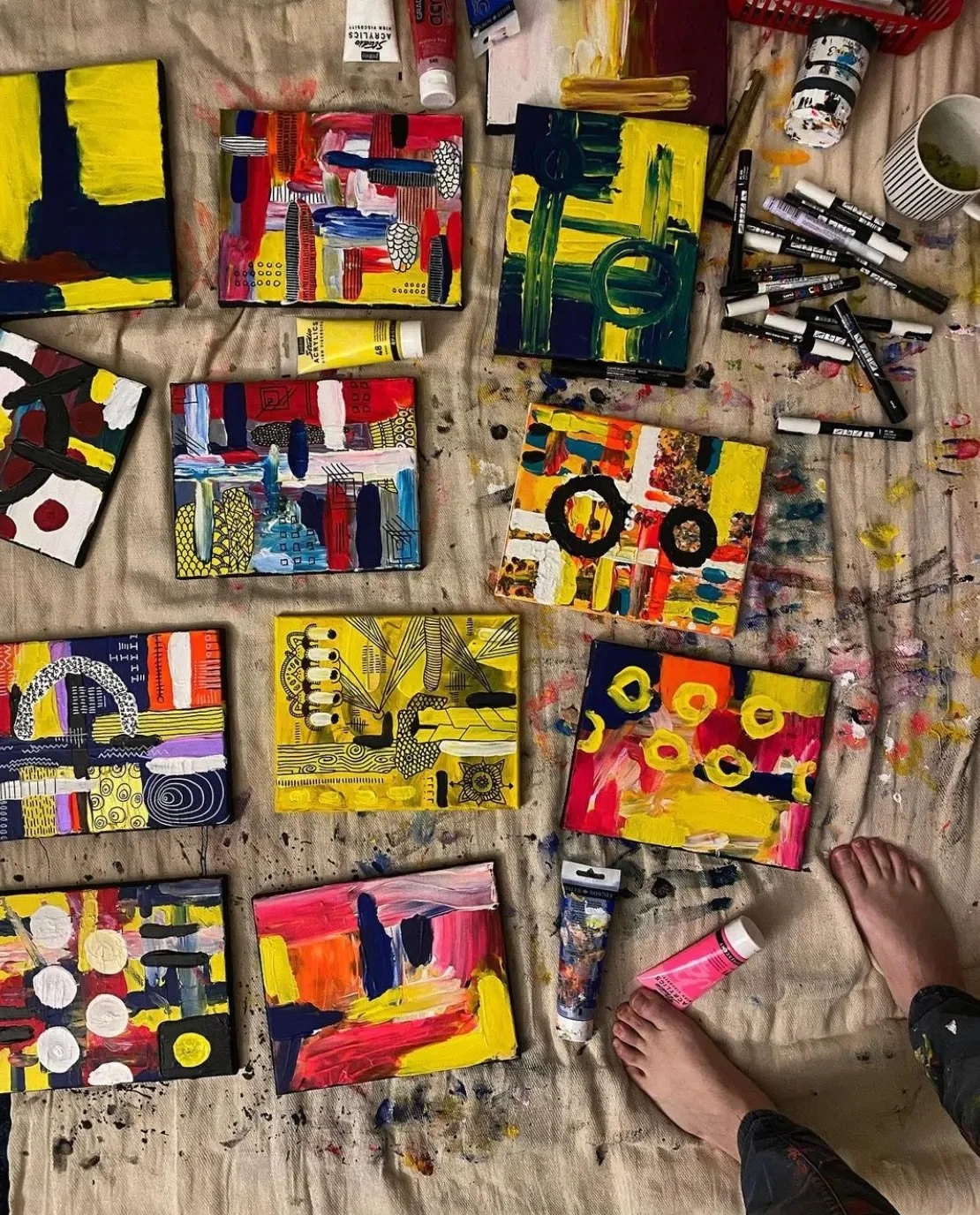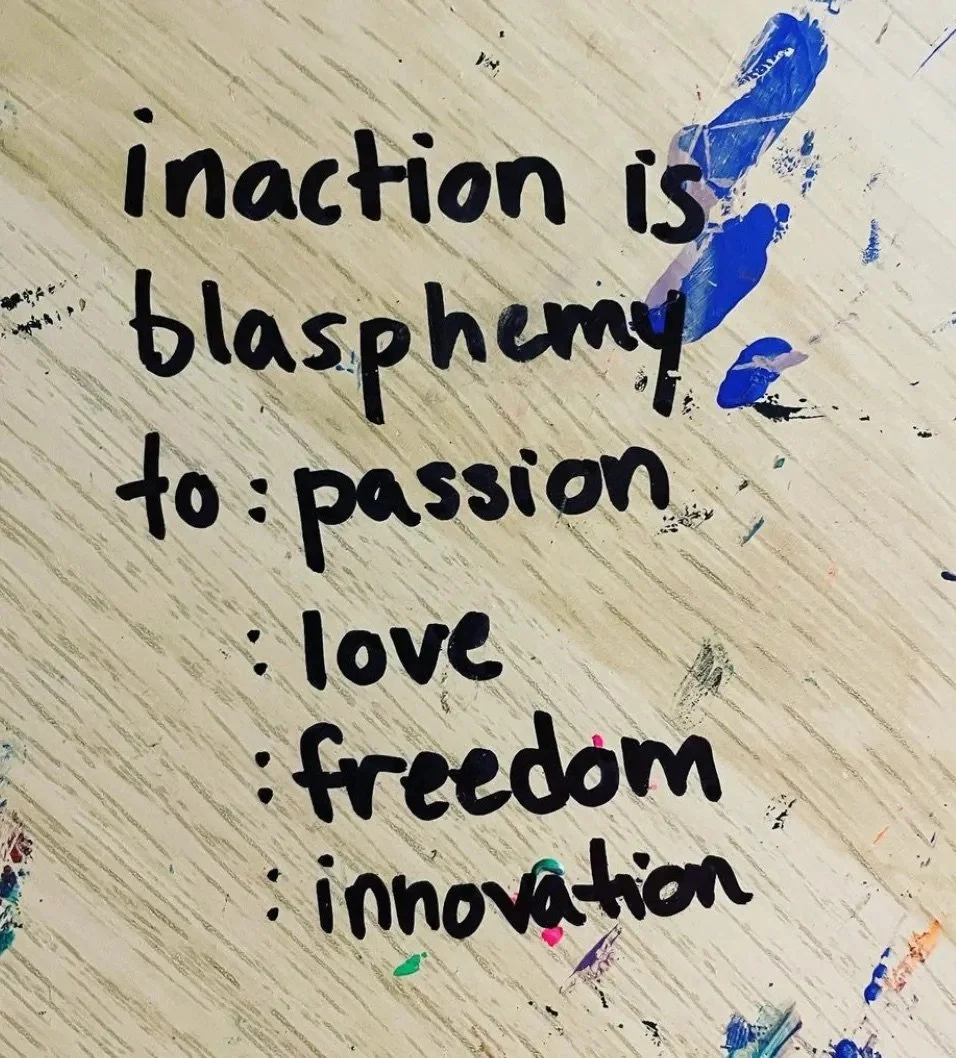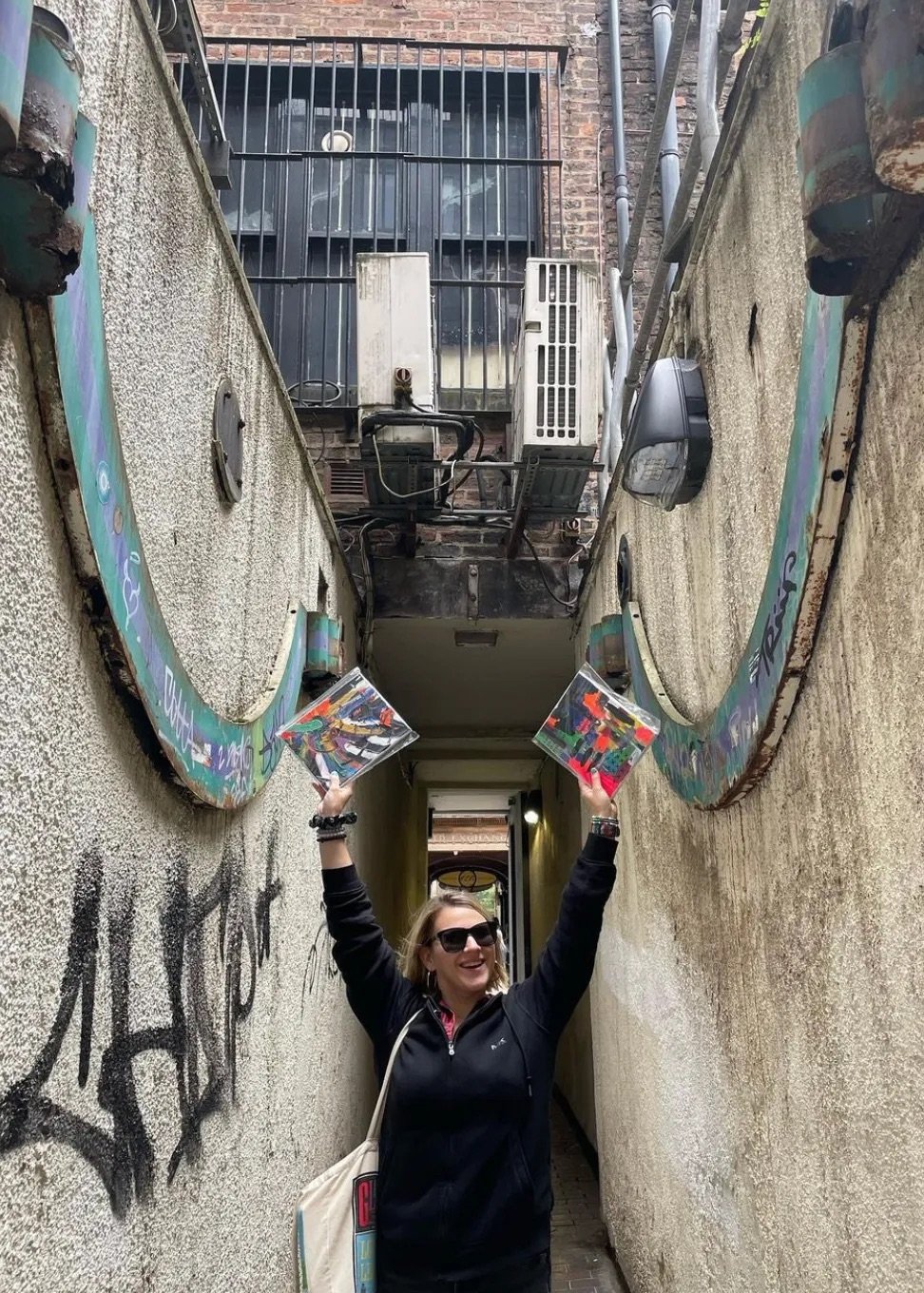Lost and found, a story of revival
On losing and reviving my creative spirit
Lost
Almost two decades ago (yikes), I entered my university years excited to dive into the liberal arts. I jumped into art, history, theology and philosophy classes and revelled in the cycles of learning and creating. I loved weaving what I was learning into the art I was making; and how making and sharing art taught me even more.
But of course it was during those years that my personal responsibilities were growing and the student loans that enabled me to enjoy this environment of learning were beginning to stack up. I had to find a way to make my liberal arts education celebration pay my bills after graduation; so I dove into my university course catalog and zeroed in on graphic design as an option for generating more commercial opportunities.
I began replacing the pursuit of knowledge, learning and artistic expression with the pursuit of getting a job to pay back my impending debts. The real American dream.
Honestly I had no idea what graphic design was before I joined the course, I didn’t have one of those good ‘why’ stories to be in the course—but I knew it would teach me to use software and presented some decent career pathways. Before then, my technical expertise was limited to Word, Paint and Myspace.
So there I went—I learned a whole new set of software tools called Adobe Creative Suite, and a couple years later earned the right to call myself a graphic designer. After graduation I found an ad on Craig’s list for a graphic designer at a small publishing company, applied and got the job. My student loan bills got paid on time, interest and all.
But my day job wasn’t as creative as I had hoped. The work felt more like solving puzzles and pushing pixels than generating new and creative work. So, to give myself a creative outlet, I started accepting commissions outside of work, and moonlighting as a freelance designer.
My hope was that by doing work on my own terms, I would have more creative control over the output. I managed to bag a few fun little projects—some tee shirt designs that I got creative with, and few branding jobs. But over time, moonlighting started to put a strain on me—I became overworked.
So I toned down the commissions and tried to get back to my roots of painting, drawing and doing art; but I felt like no matter what I did, it needed to be suitable to sell. By this point, I had forgotten what fun art could be and had completely tangled up my work with the need to monetize it.
I had an Etsy shop, and I did a couple of art fairs, but I wasn’t making many sales. I was struggling to break even. I didn’t realize it, but I had bonded the very idea of being creative with the target of making money. I lost touch. And I started to believe, like so many of us do, that freedom was something you found after you paid your bills.
So I gave up trying to do art and instead gave all of my excess time and energy to my day job, and eventually to building a freelance graphic design business. I gave away my art supplies. I stopped practicing art altogether.
Emergence
When I was 29, I made the decision to move across the pond with my then-partner; and it was during that move that I found myself doodling and making collages in my sketchbook again, organically—something I hadn’t done in years. It became my way of dealing with the new environment and challenges I was facing—culture shock, career changes, assimilating in new region, new latitude. We’ll call it a “major life event.”Sketching and journalling became my emotional home. Sometimes to jot down some observations or journal about something; but mostly to draw or make collages—to create. The friction I had developed to doing art before was finally slipping away because art was no longer an object of potential income, but rather a salve for the stresses of life.Through all this, I started picking up canvases again, and started painting—with no aim other than to fill the space around me with art that I loved, for me.
Found
I began painting and drawing again, and more than that I began experimenting with different materials, methods and constraints. During one period, I gave myself a constraint that I could only create with scissors and glue — no mark making. At another time I decided to throw out all of my paint brushes and paint only with my hands or with found objects.
It was in those moments that I found my style and arrived at a place that I thought was only available in the innocent years of youth. Making sales was the last thing on my mind; I did the art because I needed to and because I could. I found an immense gratitude for having the freedom and the resources to simply create.
I was discovering the state of the art, it was there all along, but I missed it because in my twenties, I was busy trying to paint things that I thought would please people, only to find I was completely ignoring the one thing that makes art great: love.
Constrained
After reaching this state of art and enjoying it for a while, I decided to start looking for studio space in the city to take my work to the next level—maybe I would actually start selling my work. But then my dream got knocked back by one detail in the immigration fine print.
As an immigrant on a Tier 2 visa in the UK (recently changed to “skilled worker”), I am not permitted to make an income from any other source than my employer (sponsor). The only exception is if I were to do part-time contract work (moonlighting) performing the same role for someone else as I do for my employer. That was the deal I signed up for, for five years. (Please if you are an immigrant, check the regulations from time to time as they do change!)
But by this point in my life, I had learned to thrive on constraints. Technically I wasn’t allowed to sell my work; but no way was that going to stop me from doing what I loved. And sure I probably could have found some workarounds but I knew it would be best not to complicate things.
Of course—I could volunteer my time and energy however I wanted, so I decided I would do so proflically, and I would do it for love.
Committed
So I committed to the work in October 2019 with the idea to do a random act of kindness for my 33rd birthday by painting and giving away 33 paintings. I spent weeks getting the canvases ready, working on them in the evenings, and on the night of 3 November 2019 I placed 33 cello-wrapped canvases containing friendly notes around Sheffield, like easter eggs. Then I posted a note out on social media, and waited. The next day, the response was so overwhelmingly warm and positive. I felt like I had spread actual rainbows in the world, and I got rewarded by having some light reflected back on me.
You really do reap what you sow!
From that first drop I knew I had to keep going, so I set a goal back then to paint and give away 500 paintings.
I imagine each painting that I drop is like a seed of love and light; I know they’re not all going to take root, but I have faith that a few seeds will blossom. I hope my work inspires others to find the work that brings them to a place of love and gratitude; and I hope my giving encourages others to share their gifts with the world too. The world needs injections of love and light.
Lessons and rewards
Four years later, I’ve completed 240 art drops, I’ll be doing another big drop at Glastonbury (festival) in a couple of weeks. Most of my art has been dropped here in Sheffield, where I live, but I’ve also dropped canvases in Manchester, Leeds, Liverpool, London, Edinburgh as well as Lisbon, Saville, Berlin, and Barcelona. I even did a few “postal drops” during lockdown, mailing canvases as far away as California.
I committed to a repetitive practice, and I committed to the process.
I committed to not knowing what the outcomes would be. And yet the lessons and rewards have been so great. Some of the lessons I’ve learned are:
You truly do reap what you sow, and the greatest gift you can give are gifts that come from a place of love within you—not from a place of seeking validation (creating things you hope other people will like).
Everything is a practice—art is a practice. If you make a practice of coming to any task repetitively, each time you arrive you’ll find it’s easier to get started. Those blank canvases are intimidating at first, but the more you commit to the practice of art (or any creative act), the more creativity you’ll find within yourself.
It’s critically important to act. Every inaction is a missed opportunity. Better outcomes do not arise from better dreaming or visioning; better outcomes arise from action.
In the end, I think the most important lesson I learned is simply to do what you love—to truly surrender to your art. And not care if the work you’re doing has a place to go, or a market to sale to; just trust that your work deserves to be realized, first and foremost.
And the rewards? Every time I’ve done a drop I’ve got waves of love and appreciation back from those who have found my paintings or heard the story. And for me, there’s no greater rush than hearing I’ve inspired someone else to take similar action, to do the work that is in their heart and share it with the world. My work has created ripples of positivity, and that’s hugely rewarding.
I believe that every moment I spend surrendering to my creative work brings a return. That return might not look like a paycheck, but the energy I gain from pursuing the work I love gives me strength to do things now I never thought I was capable of.
What’s stopping you?
What’s holding you back? Are you avoiding trying something new or holding back your gifts because it might not come with a paycheck? Could it be for fear or shyness?
What if you took the pressure off and created a world for yourself where none of that mattered? What would it look like if the thing you loved doing came easily to you, and was easy to accomplish?
It’s easy for us to build fortresses around our hearts and stop ourselves from doing what makes us happy—from doing our life’s work. The world is complicated, capitalistic, sometimes malevolent—we’re all hurt in some way, and we all have those experiences that knick and cut away at us.
I broke out of that fortress, initially due to a major life change, but ultimately because I set up a process that turned this work into a simple practice I could do a few times a week—like meditating or going to the gym. I keep a note on my desk that says, “What would it look like if it were easy?” (picked up from Tim Ferriss) to remind myself not to overcomplicate the work I love doing most.
Whether you do the work just for you or whether you want to practice in the open (e.g. social media): just commit to a practice. Commit to knowing that you will change or iterate on your work as you move along, but that’s ok because it’s natural to do. All living things evolve and re-generate from time to time.
Surrender to your art.
If you’ve read this far, thank you. I appreciate you being here, it means a lot.
If you enjoyed this, please share this with a friend. I’ll write again soon to share more learnings and insights from the state of the art. Until then, I hope you find ways to practice your gifts.
